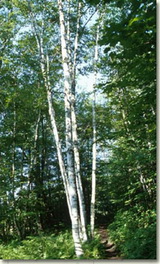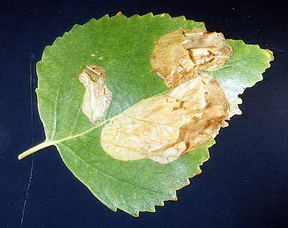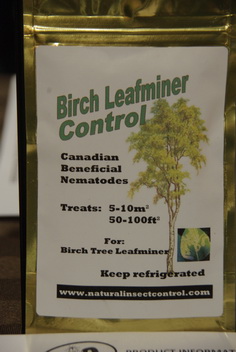|
The Paper Birch
|
|
|

Keeping the Paper Birch in a healthy active growing state will help it ward off or survive the attack of a very common pest. The Birch Leaf Miner, Fenusa pusilla is a sawfly whose larva does considerable damage to the foliage of Paper Birch and most other Birch species. The adult sawfly hatches from the soil as it warms up in the spring, about 10̊C is the soil temperature that wakes up the overwintering pupa. The adult lays eggs in a slit on newly emerging leaves and these eggs hatch into the leaf miner that causes all of the damage. This little worm lives between the upper and lower surface of the leaves and eats all the delicious soft tissue it finds there. The result is a brown crisp section in the middle of the leaf. Although this is quite unsightly in a landscape specimen it is unlikely to kill a healthy tree.
 There is another species of leaf miner, Profenusa thomsoni that is more prevalent in the western parts of N. America but it’s cause and effect are quite similar. The city of Edmonton has had some success controlling this pest with a small parasitic wasp. I am unable at this time to give you a source for this biological control.
There is another species of leaf miner, Profenusa thomsoni that is more prevalent in the western parts of N. America but it’s cause and effect are quite similar. The city of Edmonton has had some success controlling this pest with a small parasitic wasp. I am unable at this time to give you a source for this biological control.
The control of the more common Fenusa sawfly is made quite difficult by its life cycle. The adult sawfly lives for only a few days as it lays its eggs and hitting it with a contact spray would take superb timing and aim. The standard control used to be applications of Cygon 2E a systemic insecticide that made the leaves toxic to the little worms. It has been justifiably banned in many jurisdictions as it is a very nasty, toxic chemical. Various oil sprays can be applied, to the emerging leaves, early in the spring and that will inhibit the adults ability to lay eggs.

Most recently a biological control using parasitic nematodes has found to be quite successful. The nematodes are applied to the soil in the spring before the adults start to emerge and are well watered in. They attack the larva in the soil and stop them from hatching into adults. These beneficial nematodes are available as a packaged product specifically for the control of Birch Leaf Miner. This product from Natural Insect Control contains three different nematodes, Steinernema felitia, Steinernema carpocapsae and Heterohabditis bacteriophora, for those of you scientific enough to care, that apparently provide a high degree of control, making the Paper Birch, a desirable and easily maintained ornamental tree.
I have not used this product but I have used other nematodes from this company to control the Iris borer in my gardens. I plan to try this new product this spring, 2011, because it is also supposed to work on Fenusa ulmi the nasty beast that mines the leaves of my Camperdown Elm.
